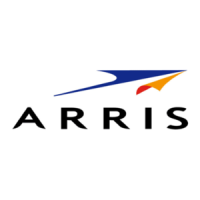Chapter 19: DOCSIS Set-top Gateway Configuration
STANDARD Revision 1.0 C4® CMTS Release 8.3 User Guide
© 2016 ARRIS Enterprises LLC. All Rights Reserved. 635
The command to display the entries in the client id list is:
show cable dsg client-id-list [<clIdList>]
Vendor-specific Parameters
Vendor-specific parameters can be specified with the DSG tunnel Group as well as with the client IDs. When there are
multiple VSP lists specified for a single rule, the VSP entries from all the lists are included with the rule in the DCD. If a VSP
list is referenced multiple times for the same rule, only one copy of the VSP list is included with the rule in the DCD.
QoS
Rate Limiting/Policing — Rate limiting (also termed policing), as it pertains to DSG, can be enforced on the CMTS by using
the Service Class Name association as described by the DSG specification. A Service Class Name is a the more direct means
of enforcing rate limiting for DSG. Service Class Names are a DOCSIS construct for defining Quality of Service (QoS)
parameter sets. For details on Service Class Names, see Service Class Names.
Simply put, a Service Class Name can be associated with a DSG tunnel rule. See the configure cable dsg tunnel comand
in the Command Line Descriptions (page 1127) chapter for more detail. The QoS parameters, including minimum and
maximum traffic rates, are then automatically applied to the tunnel, and the CMTS uses those QoS parameters to rate limit
the traffic which flows over the DSG tunnel.
If No SCN Is Associated — If no Service Class Name is explicitly associated with a DSG tunnel, then the maximum data rate
on any given DSG tunnel defaults to 2.048 Mbps.
Note: Even though a default maximum traffic rate is applied if no SCN association is explicitly made, ARRIS strongly
recommends association of an appropriately provisioned service class name to each DSG tunnel. This ensures enforcement
not only of an appropriate maximum traffic rate, but also of an appropriate traffic priority. Consideration should be given
to the accumulated sum of traffic that will pass through any single device host, which may actually have multiple tunnels
sourcing data to that single device. The maximum traffic rates on all tunnels that funnel into any single device should be
provisioned accordingly to ensure that the accumulated total of all traffic does not exceed the recommended 2.048 Mbps
limit.
Traffic Prioritization and DSG — As stated above, traffic priority can and should explicitly be associated with each DSG
tunnel via association of an appropriately provisioned Service Class Name to each DSG tunnel. If no Service Class Name
association is made, a default traffic priority of 0 is used (this is the lowest possible traffic priority). One presumed likely

